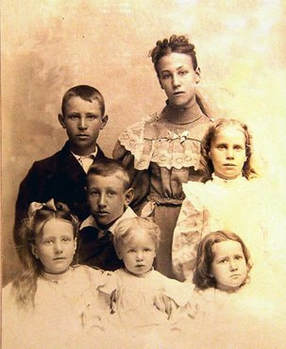 The Hartle children in 1900, one year before their parents died. The characters in Yours in a Hurry are Anna, the oldest, at top, Addison to her right and Purl, seated in front of him. The Hartle children in 1900, one year before their parents died. The characters in Yours in a Hurry are Anna, the oldest, at top, Addison to her right and Purl, seated in front of him. I love history—always have. As a daydreamer like my mother, books and films entice me. My work involves people, how we work, learn and behave with each other—or not. Behavioral science is fertile ground for a writer. I inherited great aunt Letta's "box", a life's work that substituted for a spouse—family trees, photos and letters: Los Angeles news stories about Addison, an aeroplane builder and flyer in 1911; a 1910 post card from Purl, stationed in Japan in 1910; Anna's ring, still in the original box. I had to write about them. Influences Non-fiction authors who can take facts and create an interesting story are a great read—Doris Kerns Goodwin, Eric Larson, David McCullough, Michael Shaara, and Howard Blum. Some are professional historians or reporters. I am neither. But as a history buff with a degree in English and history, writing historical fiction allows me to associate characters that may or may not have met in their time, but could have. E. L. Doctorow's Ragtime is the first historical novel I remember reading. James Michener's long sagas sustained me during a pregnancy. A British tour guide and former English Lit professor, read to us from Edward Rutherford's Sarum, which he deemed "the best novel about English history". I am enlightened listening to Colin McCann, Tracy Chevalier, and Mary Doria Russell tell their writing successes and challenges. Yours in a Hurry My first book is about orphaned siblings, Anna, Addison and Purl Hartle, who leave their Ohio village in 1909 for better opportunities after receiving a good inheritance. They meet aviators, inventors, and Hollywood icons. Purl helps develop military bases in Hawaii and the Philippines. Addison, who travels a lot, is always involved in the next new thing and often signs his letters 'Yours in a Hurry'. Follow these blogs to learn about the early 1900's and experience the people and places I've discovered along the way. I know you'll enjoy the journey as much as I have.
0 Comments
Leave a Reply. |
Archives
August 2020
Categories
All
|
 RSS Feed
RSS Feed